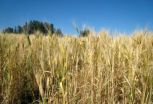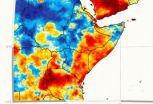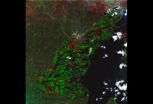(Press-News.org) Using modern weather satellites to monitor rainfall has become a robust, widely practiced technique. However, establishing a reliable context for relating space-based rainfall observations to current and historical ground-based rainfall data has been difficult.
A new dataset developed in partnership between UC Santa Barbara and the U.S. Geological Survey (USGS) can be used for environmental monitoring and drought early warning. The Climate Hazards Group Infrared Precipitation with Stations (CHIRPS), a collaboration between UCSB's Climate Hazards Group and USGS's Earth Resources Observation and Science (EROS) couples rainfall data observed from space with more than three decades of rainfall data collected at ground stations worldwide.
"This dataset seeks to blend the best qualities of rainfall station observations, satellite temperature data and rainfall's unique spatial characteristics to create the best available rainfall information for climate and agricultural monitoring," said Gregory J. Husak, an assistant researcher with the Climate Hazards Group in UCSB's Department of Geography.
The new dataset allows experts who specialize in the early warning of drought and famine to monitor rainfall in near real-time, at a high resolution, over most of the globe. CHIRPS data can be incorporated into climate models, along with other meteorological and environmental data, to project future agricultural and vegetation conditions.
Specifically designed for drought monitoring, CHIRPS is already being used to identify possible hot spots of food insecurity. Much of East Africa is still recovering from a series of poor rainy seasons in 2008, 2009, 2011 and 2012. Food prices remain high, especially in South Sudan, where civil war has led to the displacement of more than a million refugees.
Kenya relies heavily on highly productive farms located in the Rift Valley by Lake Victoria. Usually, abundant spring rains support high crop yields that feed millions of people. This year, however, the CHIRPS dataset has identified a very poor start to the growing season. CHIRPS' long historical record indicates that April's rainfall total was the lowest in 34 years (about two inches for the entire month). This information has been passed along to the Famine Early Warning Systems Network of the U.S. Agency for International Development (USAID), prompting on-the-ground assessments of potential crop failure.
In addition to providing high-resolution, near real-time information to support early warning, UCSB and USGS scientists are also using the CHIRPS data to explore recent trends in rainfall. For instance, long-term rainfall has been declining across both the southwestern United States and easternmost part of East Africa. The scientists are working with USAID to incorporate this information into development and adaptation strategies in Africa.
"Our most recent research suggests that these declines are likely linked to warming in the western Pacific and eastern Indian oceans," said Chris Funk, a research scientist with the USGS' EROS.
INFORMATION:
CHIRPS data can help guide climate-smart development. It can also help water managers, hydroelectric power companies, natural resource managers and disaster relief agencies prepare for a changing climate.
Available to the public, the CHIRPS data archive is hosted by both the UCSB Climate Hazard Group and USGS' EROS. Its development has been funded by USGS, USAID, the NASA Applied Sciences Program and the National Oceanic and Atmospheric Administration. Scientific programmers Pete Peterson and Marty Landsfeld, members of the Climate Hazards Group, curated the satellite and station datasets used to build the CHIRPS.
The state of rain
UCSB's Climate Hazards Group develops a satellite-based rainfall monitoring dataset to support the early detection of drought globally
2014-05-15
ELSE PRESS RELEASES FROM THIS DATE:
Study finds hazardous flame retardants in preschools
2014-05-15
Berkeley — A new study of preschools and day care centers finds that flame retardants are prevalent indoors, potentially exposing young children to chemicals known to be hazardous.
The study, to appear online Thursday, May 15, in the journal Chemosphere, was led by researchers at the University of California, Berkeley, and funded by the California Air Resources Board. Although many infants and young children spend up to 50 hours per week in day care, the study authors noted that this paper represents the first systematic review of flame retardants in early child care ...
West Antarctic Ice Sheet collapse is under way
2014-05-15
The West Antarctic Ice Sheet, which holds enough water to raise global seas by several feet, is thinning. Scientists have been warning of its collapse, based on theories, but with few firm predictions or timelines.
University of Washington researchers used detailed topography maps and computer modeling to show that the collapse appears to have already begun. The fast-moving Thwaites Glacier will likely disappear in a matter of centuries, researchers say, raising sea level by nearly 2 feet. That glacier also acts as a linchpin on the rest of the ice sheet, which contains ...
Phase I data suggest PLX3397 is a potential therapy for patients with advanced PVNS
2014-05-15
NEW YORK, NY, May 14, 2014 — A novel targeted drug shows promise in treating patients with advanced pigmented villonodular synovitis (PVNS), a rare neoplastic joint disorder, according to new phase I data from Memorial Sloan Kettering Cancer Center and other institutions highlighted to media today in advance of the 50th Annual Meeting of the American Society of Clinical Oncology (ASCO), which will take place from May 30 to June 3 in Chicago.
At the time of interim analysis, 11 of 14 evaluable patients (79 percent) had a partial response to the drug and three patients ...
Critical access hospitals have higher transfer rates after surgery
2014-05-14
Hospital transfers happened more often after surgery at critical access hospitals (CAHs) but the proportion of patients using post-acute care was equal to or less than that of patients treated at non-CAHs.
The CAH designation was created to provide financial support to rural hospitals. As such, they are exempt from Medicare's Prospective Payment System and instead are paid cost-based reimbursement. The proliferation of CAHs after the payment policy change has increased interest in the quality and cost of care these facilities provide.
The authors used data from ...
Study examines prenatal exposure to tobacco smoke on inhibition control
2014-05-14
Individuals prenatally exposed to tobacco smoke exhibited weaker response in some regions of the brain while processing a task that measures inhibition control (the ability to control inappropriate responses).
Prenatal tobacco smoke exposure is a risk factor for adverse physical and mental outcomes in children. Growing evidence suggests that smoking during pregnancy may increase the risk of psychopathology such as attention-deficit/hyperactivity disorder (ADHD). Research on ADHD has suggested that individuals with the disorder may exhibit poor inhibitory control.
Functional ...
Reduction in volume in hippocampus region of brain seen in psychotic disorders
2014-05-14
Reduction in brain volume in the hippocampus (a region related to memory) was seen in patients with the psychotic disorders schizophrenia (SZ), schizoaffective disorder (SZA) and psychotic bipolar disorder (BPP).
The pathophysiology of psychotic disorders remains unclear, especially SZ. Changes in volume in the hippocampus are a hallmark of SZ. Advances in image processing allow for the precise parceling of specific hippocampal areas.
The authors conducted a neuroimaging study in patients with psychotic disorders and healthy volunteers as part of the multisite ...
MAVEN solar wind ion analyzer will look at key player in Mars atmosphere loss
2014-05-14
This past November, NASA launched the Mars Atmosphere and Volatile Evolution (MAVEN) mission in the hope of understanding how and why the planet has been losing its atmosphere over billions of years.
One instrument aboard the spacecraft will study a special component of the Martian atmosphere to help solve this mystery. By studying ions, or small electrically charged particles, in and above the Red Planet's tenuous atmosphere, the Solar Wind Ion Analyzer will help answer why Mars has gradually lost much of its atmosphere, developing into a frozen, barren planet.
Once ...
Different approaches needed to control cardiovascular disease risks for those with HIV
2014-05-14
Even if treated, hypertension and high cholesterol are increasingly common for people with human immunodeficiency virus (HIV), according to a new study from researchers at Mount Sinai St. Luke's and Mount Sinai Roosevelt hospitals in New York and the University of California, Davis.
The finding – published online in the Journal of Acquired Immune Deficiency Syndromes – leads the study authors to recommend greater emphasis on cardiology in HIV treatment and research.
The study authors examined medical records for a diverse group of 4,278 outpatients in New York City ...
Control methane now, greenhouse gas expert warns
2014-05-14
ITHACA, N.Y. – As the shale gas boom continues, the atmosphere receives more methane, adding to Earth's greenhouse gas problem. Robert Howarth, greenhouse gas expert and ecology and environmental biology professor, fears that we may not be many years away from an environmental tipping point – and disaster.
"We have to control methane immediately, and natural gas is the largest methane pollution source in the United States," said Howarth, who explains in an upcoming journal article that Earth may reach the point of no return if average global temperatures rise by 1.5 to ...
Beer foam secrets tapped in new study
2014-05-14
ITHACA, N.Y. – It's an unlikely beer-drinking toast: "Here's to L-T-P-One!" Yet, the secret to optimal foam in the head of a freshly poured brew, according to Cornell food science research, is just the right amount and kind of barley lipid transfer protein No. 1, aka LTP1.
Bitter compounds found in hops, like iso-alpha acids, are important to brewers, says Cornell's Karl J. Siebert, principal investigator and author of "Recent Discoveries in Beer Foam," set for publication in next issue of the Journal of the American Society of Brewing Chemists.
"Dissolved gases in ...
LAST 30 PRESS RELEASES:
Numbers in our sights affect how we perceive space
SIMJ announces global collaborative book project in commemoration of its 75th anniversary
Air pollution exposure and birth weight
Obstructive sleep apnea risk and mental health conditions among older adults
How talking slows eye movements behind the wheel
The Ceramic Society of Japan’s Oxoate Ceramics Research Association launches new international book project
Heart-brain connection: international study reveals the role of the vagus nerve in keeping the heart young
Researchers identify Rb1 as a predictive biomarker for a new therapeutic strategy in some breast cancers
Survey reveals ethical gaps slowing AI adoption in pediatric surgery
Stimulant ADHD medications work differently than thought
AI overestimates how smart people are, according to HSE economists
HSE researchers create genome-wide map of quadruplexes
Scientists boost cell "powerhouses" to burn more calories
Automatic label checking: The missing step in making reliable medical AI
Low daily alcohol intake linked to 50% heightened mouth cancer risk in India
American Meteorological Society announces Rick Spinrad as 2026 President-Elect
Biomass-based carbon capture spotlighted in newly released global climate webinar recording
Illuminating invisible nano pollutants: advanced bioimaging tracks the full journey of emerging nanoscale contaminants in living systems
How does age affect recovery from spinal cord injury?
Novel AI tool offers prognosis for patients with head and neck cancer
Fathers’ microplastic exposure tied to their children’s metabolic problems
Research validates laboratory model for studying high-grade serous ovarian cancer
SIR 2026 delivers transformative breakthroughs in minimally invasive medicine to improve patient care
Stem Cell Reports most downloaded papers of 2025 highlight the breadth and impact of stem cell research
Oxford-led study estimates NHS spends around 3% of its primary and secondary care budget on the health impacts of heat and cold in England
A researcher’s long quest leads to a smart composite breakthrough
Urban wild bees act as “microbial sensors” of city health.
New study finds where you live affects recovery after a hip fracture
Forecasting the impact of fully automated vehicle adoption on US road traffic injuries
Alcohol-related hospitalizations from 2016 to 2022
[Press-News.org] The state of rainUCSB's Climate Hazards Group develops a satellite-based rainfall monitoring dataset to support the early detection of drought globally





